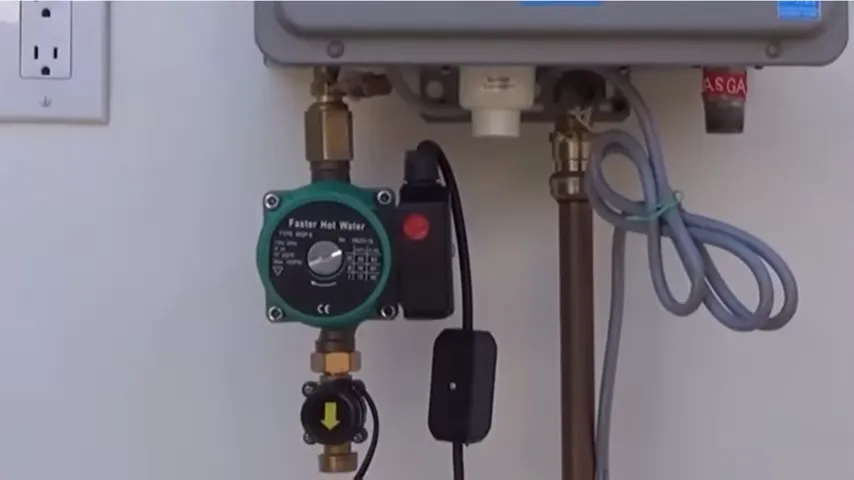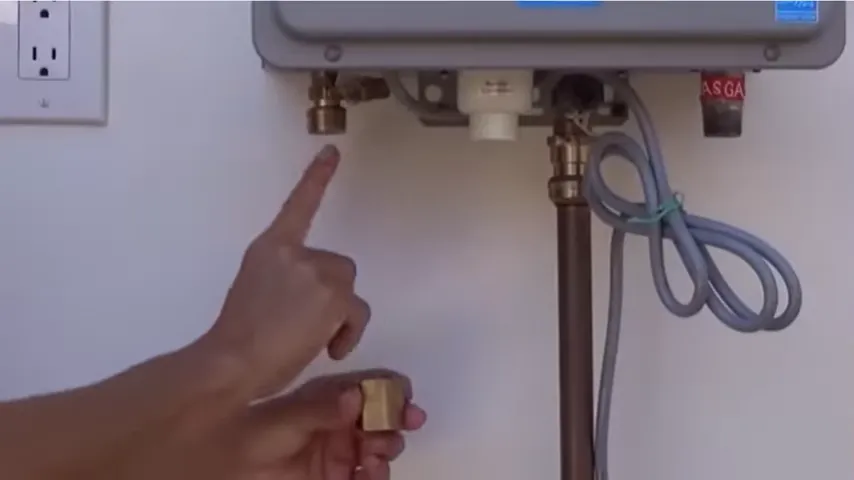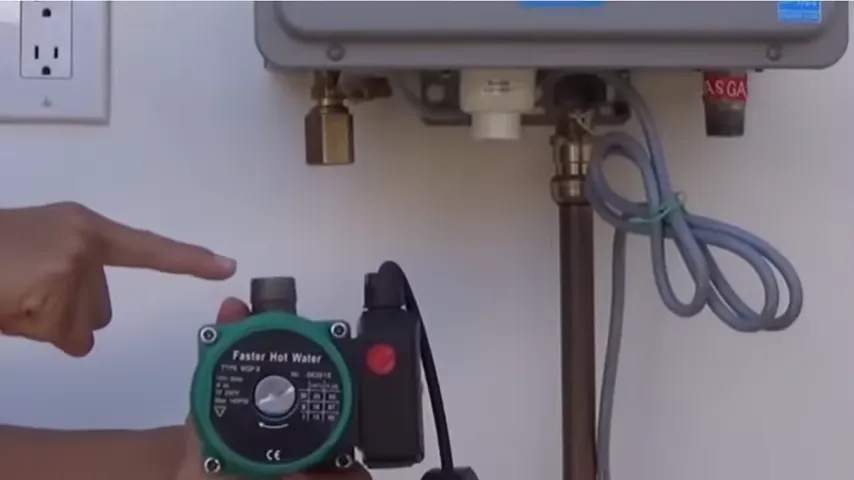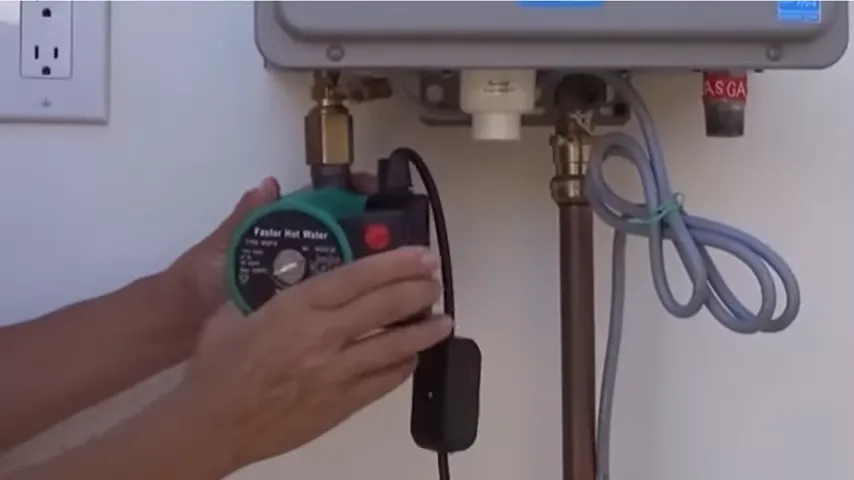To install a recirculating pump on a water heater, connect the pump to the hot water line and set up the return line to the heat source. This can help provide instant hot water throughout your home and save energy.
Are you tired of waiting for hot water to reach your faucets or showers? Installing a recirculating pump on your water heater can be the perfect solution to this problem. Not only will it provide you with instant hot water, but it can also help in conserving energy by reducing water wastage.
We will guide you through the steps required to install a recirculating pump on a water heater. Whether you are a DIY enthusiast or a homeowner looking to improve the efficiency of your hot water system, this easy-to-follow guide will help you get the job done. So let’s get started and enjoy the luxury of hot water at your fingertips!
Understanding The Benefits Of A Recirculating Pump
Understanding the Benefits of a Recirculating Pump
Installing a recirculating pump on your water heater can provide numerous benefits for your home. Not only does it improve water efficiency and convenience, but it also saves time and reduces water wastage. In this section, we will delve into the various advantages of having a recirculating pump and how it can transform your water heating experience.
How a recirculating pump can improve water efficiency and convenience
One of the key benefits of a recirculating pump is its ability to enhance water efficiency and convenience. This device works by constantly recirculating hot water throughout your plumbing system, ensuring that hot water is readily available whenever you need it. This eliminates the waiting time and the need to run the faucet or shower for several minutes to get hot water flowing.
With a recirculating pump in place, you can say goodbye to those long, wasteful minutes of waiting for the hot water to reach the desired temperature. Instead, you can enjoy immediate access to hot water with just a flick of the faucet handle. This not only saves you time but also reduces water wastage, as you no longer have to let the water run while it heats up.
Saving time and reducing water wastage with a recirculating pump
Installing a recirculating pump can be a game-changer when it comes to saving time and reducing water wastage. Picture this: you wake up on a chilly morning and head straight to the shower. With a recirculating pump, you can have hot water instantly, eliminating the need to let the water run aimlessly until it reaches the desired temperature. This simple addition to your water heating system can save you precious minutes every day and help you start your day off on the right foot.
Not only does a recirculating pump eliminate the hassle of waiting, but it also significantly reduces water wastage. Without a recirculating pump, each time you need hot water, you would have to run the faucet or shower until hot water finally reaches the tap. This results in gallons of water needlessly going down the drain. However, with a recirculating pump, hot water is always readily available, reducing the amount of water wasted during the heating process.
In conclusion, a recirculating pump offers many benefits for homeowners. Its ability to improve water efficiency and convenience makes it a valuable addition to any water heating system. By eliminating the need for waiting and reducing water wastage, this device ensures that you can enjoy hot water instantly while also saving time and being environmentally conscious. With these advantages in mind, it’s clear that installing a recirculating pump is a smart investment that can greatly enhance your water heating experience.

Choosing The Right Recirculating Pump For Your Water Heater
When it comes to having hot water instantly available at every faucet and shower in your home, installing a recirculating pump on your water heater is an excellent solution. However, with various options available on the market, it’s important to choose the right recirculating pump for your water heater. In this article, we will explore the factors to consider when selecting a recirculating pump, as well as how to determine the appropriate size and capacity for your needs.
Factors to consider when selecting a recirculating pump
Before making a purchase, it’s crucial to keep several key factors in mind when selecting a recirculating pump for your water heater. These factors will ensure that you choose a pump that perfectly aligns with your specific requirements. Let’s explore these factors in detail:
- Flow rate: The flow rate of a recirculating pump determines how quickly hot water is circulated throughout your home. Consider the number of faucets and showers you have, as well as the distance between the pump and each fixture. This information will help you choose a pump with an adequate flow rate to meet your needs.
- Noise level: The noise generated by a recirculating pump may vary from model to model. If noise is a concern for you, look for pumps specifically designed to operate quietly. This will ensure a comfortable environment without any disturbing humming or vibrating sounds.
- Energy efficiency: Opting for an energy-efficient pump is not only good for the environment but also for your wallet in the long run. Look for pumps that have high energy efficiency ratings, such as those with low wattage motors. These pumps will help you save on electricity bills while providing hot water on demand.
- Durability and warranty: Investing in a durable recirculating pump is essential to avoid frequent replacements. Check for pumps made from high-quality materials that are designed to last. Additionally, ensure the pump comes with a sufficient warranty period to protect you against any manufacturing defects or malfunctions.
- Installation requirements: Different recirculating pumps may have different installation requirements. Some pumps can be easily installed by homeowners, while others may require professional assistance. Consider your level of expertise and the complexity of the installation process before making a decision.
Determining the appropriate size and capacity for your needs
In addition to considering the factors mentioned above, it’s crucial to determine the appropriate size and capacity of the recirculating pump for your water heater. Knowing the right size and capacity will ensure efficient water circulation and prevent any performance issues.
To determine the size and capacity, you need to consider the following:
- Pipe diameter: Measure the diameter of the pipes connected to your water heater. Choosing a recirculating pump that matches the pipe diameter will ensure a proper fit and optimal performance.
- Water heater type: Different types of water heaters may require different pump sizes and capacities. Check the manufacturer’s guidelines or consult a professional to determine the appropriate pump specifications for your specific water heater model.
- Hot water demand: Evaluate the hot water demand in your household by considering the number of occupants and their usage patterns. If you have a large household with high hot water demand, you might need a more powerful pump to provide sufficient hot water throughout the day.
By considering these factors and properly determining the size and capacity, you can confidently choose the right recirculating pump for your water heater. This will ensure you have instant access to hot water whenever you need it, bringing convenience and comfort to your daily life.

Preparing For The Installation Process
Before you start installing a recirculating pump on your water heater, it’s important to properly prepare for the process. This will ensure that everything goes smoothly and that you have all the necessary tools and materials on hand. Here are the steps to get you ready:
Gathering the necessary tools and materials
In order to install a recirculating pump on your water heater, you’ll need a few key tools and materials. Before you begin the process, make sure you have the following:
- Recirculating pump: It is important to choose a pump that is compatible with your water heater and meets your needs. Consider factors such as flow rate and energy efficiency.
- Tools: You’ll need a pipe cutter, pipe wrench, adjustable wrench, tubing cutter, soldering torch, flux, solder, Teflon tape, and a screwdriver.
- Pipes and fittings: Depending on your setup, you may need copper pipes, elbows, tees, and couplings.
- Electrical components: If your recirculating pump requires electricity, you’ll need wire nuts, electrical tape, and a power source.
By having all of these tools and materials ready to go, you can ensure a smooth and efficient installation process.
Shutting off the water supply and power to the water heater
Before you start any work on your water heater, it’s crucial to shut off both the water supply and power to the unit. This will prevent any accidents or damage from occurring during the installation process. Here’s how to do it:
- Locate the main water shut-off valve in your home. This valve is usually located near the water meter.
- Turn the valve to the “off” position to stop the flow of water to the water heater. This will ensure that no water is being heated while you work.
- Next, locate the power supply to your water heater. This is typically a circuit breaker in your electrical panel.
- Flip the circuit breaker to the “off” position to cut off power to the water heater.
- It is always a good idea to double-check that both the water and power are completely shut off before proceeding with the installation.
By following these steps, you can rest assured that the water and power to your water heater are safely turned off, allowing you to install the recirculating pump without any issues.

Installing The Recirculating Pump
Positioning the pump and routing the plumbing lines
Before you can start installing the recirculating pump on your water heater, you need to carefully position the pump and plan the routing of the plumbing lines.
First, make sure to find a suitable location for the pump near the water heater. This could be on the hot water discharge line, close to the water heater, or near the fixtures where you wish to have instant hot water. Keep in mind that the pump needs to be easily accessible for maintenance and repairs.
Once you have determined the position, it’s time to route the plumbing lines. You will need to connect the pump to the hot water discharge line and create a loop that connects back to the cold water inlet. This loop will allow the recirculating pump to circulate hot water back through the pipes, ensuring instant hot water at the fixtures.
In order to achieve proper circulation, you will need to install a bypass valve in the plumbing line. This valve will regulate the flow of water through the loop, allowing you to control the recirculation process. Make sure to choose a valve that is compatible with your plumbing system and follow the manufacturer’s instructions for installation.
Connecting the pump to the water heater and hot water line
With the positioning of the pump and the routing of the plumbing lines complete, it’s time to connect the recirculating pump to the water heater and hot water line. Follow these steps to ensure a proper connection:
- Start by shutting off the power supply to the water heater. This will ensure your safety during the installation process.
- Locate the hot water discharge line on the water heater. This is usually marked with a red-colored pipe or valve.
- Using a pipe wrench or adjustable pliers, disconnect the hot water discharge line from the water heater. Make sure to have a bucket or container ready to catch any water that may spill out.
- Install a tee fitting onto the water heater’s hot water discharge line. This fitting will serve as the connection point for the recirculating pump.
- Attach the recirculating pump to the tee fitting using appropriate fittings and connectors. Tighten the connections securely to prevent any leaks.
- Next, connect the other end of the recirculating pump to the plumbing line that you previously routed. Again, use fittings and connectors to ensure a tight and secure connection.
- Once all the connections are secure, turn on the power supply to the water heater.
With the recirculating pump properly installed and connected to the water heater and hot water line, you can now enjoy the convenience of instant hot water at your desired fixtures. Remember to check for any leaks and regularly maintain the pump for optimal performance.

Wiring And Powering The Recirculating Pump
Installing a recirculating pump on your water heater can greatly improve the efficiency and convenience of your hot water system. However, it’s important to ensure that the pump is properly wired and powered to ensure safe and reliable operation. In this section, we will guide you through the process of connecting the pump to an electrical power source and ensuring proper grounding and electrical safety.
Connecting the pump to an electrical power source
Before connecting the recirculating pump to an electrical power source, make sure you have read the manufacturer’s instructions and understand the electrical requirements of the pump.
To connect the pump, follow these steps:
- Locate a power source near the water heater. This can be an existing outlet or a dedicated electrical circuit.
- Turn off the power to the circuit you will be using. This can be done by flipping the corresponding breaker in your electrical panel.
- Measure the distance between the pump and the power source. It’s important to ensure that the power cord provided with the pump is long enough to reach the outlet.
- If the distance is too long, you may need to install a new outlet closer to the pump. This should be done by a qualified electrician to ensure compliance with electrical codes and safety standards.
- Plug the power cord of the pump into the electrical outlet. Make sure the connection is secure.
- Turn on the power to the circuit. You can do this by flipping the breaker back to the “on” position.
Once the pump is connected to the power source, you can move on to ensuring proper grounding and electrical safety.
Ensuring proper grounding and electrical safety
Proper grounding is essential to protect against electrical shocks and ensure the safe operation of the recirculating pump. Here are some important steps to follow:
- Double-check the grounding requirements specified by the pump manufacturer. These requirements may vary depending on the pump model and electrical code in your area.
- Ensure that the electrical outlet you are using is properly grounded. You can do this by using a socket tester or consulting with a qualified electrician.
- If the outlet is not grounded, it is recommended to hire a licensed electrician to install a properly grounded outlet.
- Inspect the power cord of the pump for any damages or frayed wires. If any issues are found, replace the power cord before proceeding.
- Securely fasten the ground wire of the pump to a suitable grounding point. This could be a grounding screw or a copper pipe connected to a grounding rod.
- Test the pump to ensure it is functioning properly before closing the access panel or covering any electrical connections.
By following these steps, you can ensure that the recirculating pump on your water heater is wired and powered correctly, providing you with a reliable and efficient hot water system.
Testing And Adjusting The Recirculating Pump
Once you have successfully installed a recirculating pump on your water heater, it’s time to test and adjust it to ensure optimal performance. Testing the recirculating pump involves checking for any leaks and addressing any issues that may arise. Adjusting the pump settings is necessary to fine-tune its performance and ensure it operates efficiently. In this section, we will explore these two crucial steps in more detail.
Checking for Leaks and Addressing Any Issues
Before proceeding with any adjustments, it is essential to first check for any leaks in the recirculating pump system. Even a small leak can lead to significant energy and water wastage over time. Taking the time to inspect the system thoroughly can help you prevent these problems and ensure a smooth operation.
To check for leaks, follow these steps:
- Visually inspect all the connections and joints in the recirculating pump system, including the pump itself, pipes, and valves.
- Check for any signs of moisture, water droplets, or pooling water near the connections.
- If you detect any leaks, promptly address them by tightening the connections or replacing faulty components.
- Once you have fixed any leaks, retest the system to ensure there are no more issues.
Taking the time to check for leaks and address them promptly will help you maintain the efficiency and effectiveness of your recirculating pump system, saving you money and reducing water wastage in the long run.
Adjusting the Pump Settings for Optimal Performance
To achieve the best performance from your recirculating pump, you may need to adjust its settings based on your specific requirements and preferences. The adjustment process involves finding the perfect balance between comfort and energy conservation. Here’s how you can do this:
- Locate the control panel of your recirculating pump. This panel may vary depending on the make and model of the pump, so refer to the manufacturer’s instructions for guidance.
- Identify the control knobs or buttons that allow you to adjust the pump settings. These settings can include the pump activation time, temperature range, and cycle intervals.
- Begin by setting the pump activation time to align with your daily hot water usage patterns. If you find that hot water is frequently needed during specific hours, adjust the activation time accordingly.
- Experiment with the temperature range on the pump. Keep in mind that higher temperatures may lead to increased energy consumption, while lower temperatures may compromise comfort.
- Adjust the cycle intervals to strike the right balance between energy conservation and convenience. Long intervals may save energy but result in longer waiting times for hot water, while short intervals may lead to excessive energy usage.
- Monitor the performance of the recirculating pump after making adjustments and fine-tune the settings as needed to achieve the desired balance between comfort and energy savings.
By adjusting the pump settings based on your needs, you can ensure that the recirculating pump operates efficiently, providing instant hot water while minimizing energy consumption.
Testing and adjusting a recirculating pump is crucial for securing its optimal performance. By checking for leaks, addressing any issues, and adjusting the settings based on your requirements, you can ensure that your recirculating pump system delivers hot water whenever you need it while conserving energy and reducing water wastage.
Maintaining And Troubleshooting The Recirculating Pump
Regular maintenance and troubleshooting are essential to ensure that your recirculating pump on a water heater continues to run smoothly. By investing a little time and effort into these tasks, you can prolong the life of the pump and avoid costly repairs or replacements. Let’s take a look at some regular maintenance tasks to keep the pump running smoothly and how to troubleshoot common problems and find solutions.
Regular maintenance tasks to keep the pump running smoothly
To keep your recirculating pump in optimal condition, it is important to perform regular maintenance tasks. Implementing these tasks will help prevent issues before they arise and ensure that your pump operates efficiently. Here are some simple steps you can take to maintain your recirculating pump:
- Check for leaks: Inspect the pump and the surrounding area for any signs of leaks. If you notice any drips or puddles, address the issue promptly to prevent further damage.
- Clean the pump: Over time, debris can accumulate in the pump, affecting its performance. Regularly clean the pump by removing any dirt or sediment that may have built up. Remember to follow the manufacturer’s instructions for cleaning.
- Inspect the wiring: Check the pump’s wiring connections for any signs of damage or loose connections. Tighten any loose wires and replace any damaged ones as needed.
- Lubricate moving parts: Some pumps have moving parts that require lubrication to function properly. Consult the user manual or manufacturer’s instructions to determine if your pump requires lubrication and how to do it correctly.
- Check the pressure: Monitor the pump’s pressure regularly to ensure it is within the recommended range. If the pressure is too high or too low, adjust it accordingly.
- Test the pump: Periodically test the pump to ensure it is operating as intended. Run hot water through the pipes and observe if the pump kicks in and circulates the water effectively.
Troubleshooting common problems and finding solutions
Despite regular maintenance, issues with recirculating pumps can still occur. By understanding common problems and their solutions, you can troubleshoot and resolve any issues promptly. Here are some common problems you may encounter and how to address them:
| Problem | Solution |
|---|---|
| The pump is not circulating hot water |
|
| The pump is making unusual noises |
|
| The pump is leaking water |
|
| The pump is constantly running |
|
By following these regular maintenance tasks and troubleshooting techniques, you can keep your recirculating pump on a water heater running smoothly and efficiently. Remember, if you encounter any major issues or are unsure about performing maintenance or repairs yourself, it is always best to seek professional assistance to avoid further complications.
Frequently Asked Questions
Where Should A Hot Water Recirculating Pump Be Installed?
The hot water recirculating pump should be installed near the water heater for efficient operation. It can be placed on the return line or below the sinks farthest from the heater.
Can You Put A Recirculating Pump On A Water Heater?
Yes, you can install a recirculating pump on a water heater. It helps to quickly circulate hot water throughout the plumbing system, providing instant hot water at faucets and showers.
How Much Does It Cost To Install A Water Heater Recirculating Pump?
The cost of installing a water heater recirculating pump varies depending on factors such as the type of pump and complexity of installation. On average, you can expect to pay between $500 to $1500 for both the pump and installation.
Is A Hot Water Recirculation Pump Better Than Point Of Use?
Yes, a hot water recirculation pump is better than point of use. It provides instant hot water throughout the house, saving time and water. It eliminates the need to wait for hot water at each faucet. With a recirculation pump, hot water is readily available when needed.
Conclusion
Installing a recirculating pump for your water heater is a cost-effective solution for instant hot water. By following the step-by-step guide outlined in this blog post, you’ll be able to enjoy hot water on demand and save both time and energy.
From understanding the benefits to gathering the necessary tools and completing the installation, you’ve now gained the knowledge to tackle this project with confidence. So go ahead, take control of your water heater, and upgrade your home’s hot water system today!